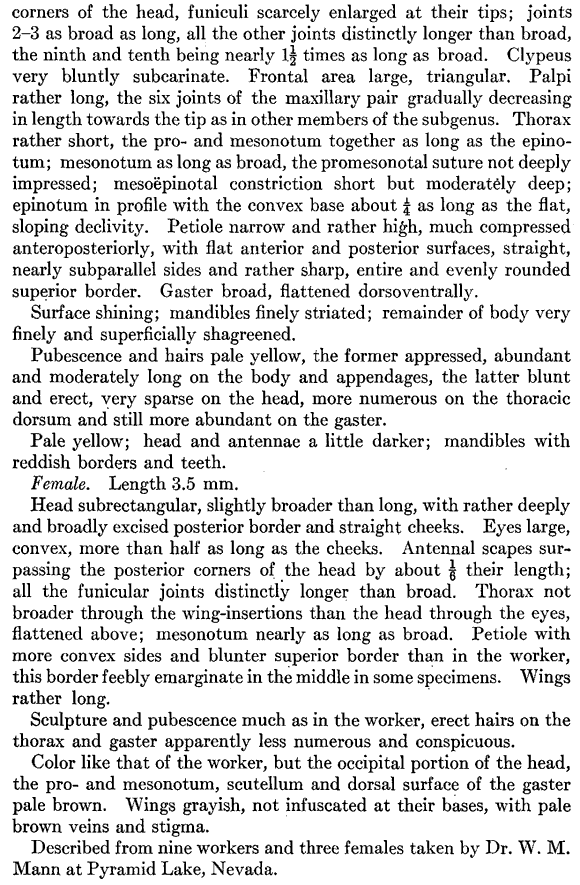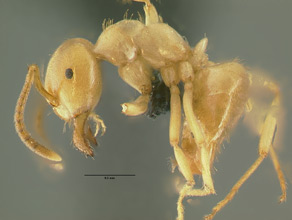- Identification
- Pale yellow workers that are quite small for a Lasius species. Lasius humilis is known only from a limited area in the southwestern United States. Workers can be confused with nanitic workers of Lasius umbratus, but differ in the absence of a promesonotal impression and the unusual shape of their petiole. The top crest of the petiole, as seen from the front, is wedge-shaped and tapers upward to form an angular, non-emarginate median prominence.
- Biology
- Beyond collection records scattered among a number of publications, there is little known about the biology of this species. Wilson (1955): "Dr. Cole has kindly supplied me with the following notes on his Colorado and New Mexico collections. The Trinidad, Colo., colony was found under a stone in the moist soil of a mountain meadow. The Tesuque Canyon, N. Mex., colony was found under a stone in moist, open pine-aspen woods." Allred (1982): "Forty five ants in two collections were found under logs, one in grass, herbs, aspen, and pine, and one in pine" (Utah records).
- additional biology notes...
- Distribution
- Range
- SW United States.
- Navajo Reservation Records
- Samples being processed.
- Additional Notes
- Gregg (1963): "This ant is extremely rare, and though the majority of the records to date are from Colorado, they by no means indicate that the center of its geographic range lies within this state. We now know that the ant is distributed over a wide area in the Rocky Mountains and Great Basin Region, but from the little that has been learned of its ecology, it seems likely the range is a discontinuous one in widely isolated localities which happen to provide the required environmental conditions.
- In addition to the record we possess from canyon meadow in Castle Park, Dr. Cole's specimens from south of Trinidad were living under a stone in moist mountain-meadow soil. Cole's New Mexico record came from Tesuque Canyon, Hyde State Park, near Santa Fe, at an elevation of 8700 ft., and was again under a stone but in moist pine-aspen woods. The conditions under which Wheeler's Salida specimens were obtained seems not to be known.
- The Colorado stations all are in the Upper Sonoran Zone, as far as I can tell, although Cole's Trinidad record would appear to be just on the border of the Transition, but until an unequivocal site for this ant in the submontane of Colorado is established I prefer to leave its zonal distribution as stated above. Although our actual altitudinal records for humilis in Colorado do not state elevations as high as 7000 feet, Wheeler's specimens from Salida must of necessity be from this altitude at the minimum."
- Etymology


- Literature
- Allred, D. M. 1982. Ants of Utah. Great Basin Naturalist. 42:415-511.
- Gregg, R. E. 1963. The ants of Colorado, with reference to their ecology, taxonomy, and geographic distribution. University of Colorado Press, Boulder.
- Wheeler, W. M. 1917. The mountain ants of western North America. Proceedings of the American Academy of Arts and Sciences. 52:457-569.
- Wilson, E. O. 1955. A monographic revision of the ant genus Lasius. Bulletin of the Museum of Comparative Zoology at Harvard College. 113:1-201.
- A note about these publications. The literature cited here is not meant to be an exhaustive list of papers published about this species.
Page authored by David Lubertazzi and Gary Alpert


